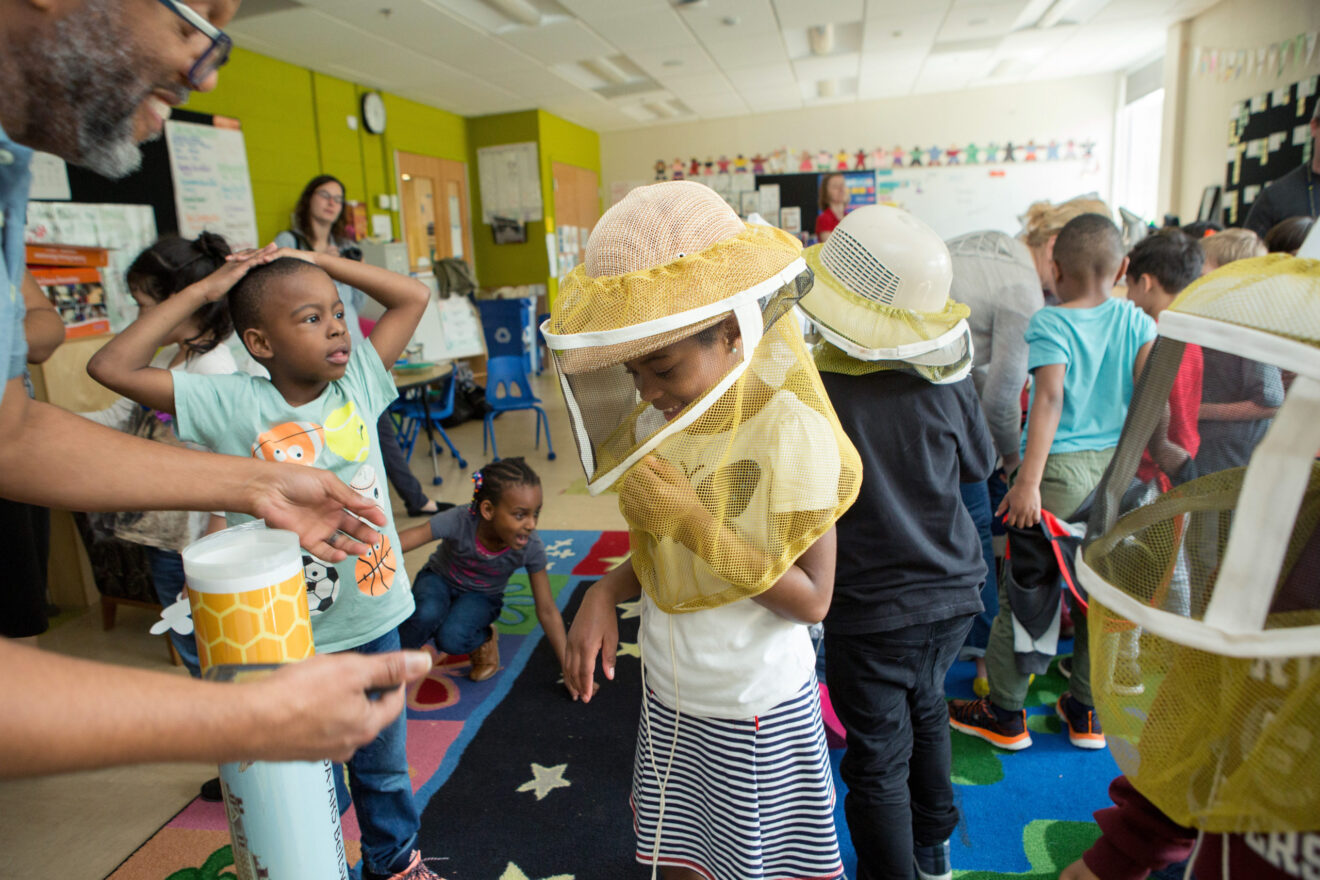Recently, Lego Education sponsored the SmartBrief-moderated “How To Ignite Joyful Learning in Classrooms” webinar, which you can access on demand. Below, we’ve pulled together some of the conversation.
Almost half of educators polled during a recent “Joyful Learning” webinar said joyful learning only influences their teaching “a little bit” or “rarely,” while 11% said it doesn’t figure in at all. The teachers said their schools don’t encourage it, or they don’t believe they have the tools for it.
Webinar panelists shared ways to turn those statistics around. Holly Gerlach, solution architect for Lego Education; Mindy Bissett, the K-8 computer science lead teacher and educator for gifted and talented students at North Little Rock School District in Arkansas; and Daniel Buhrow, STEAM teacher for third through fifth grades at McKinney Independent School District in Texas, talked about the process with moderator Katie Parsons, associate director of content for education at SmartBrief.
How joyful learning expands opportunities
Joyful learning isn’t just about having fun. It’s a purposeful way to engage students and expand their learning opportunities.
“We know that when students experience joy and learning, they comprehend more, they have higher confidence in learning, and they’re more highly engaged in class,” Parsons said.

Gerlach agreed. “Joy is at the heart of [Lego’s] instructional design,” she said. “We always believe that some of the best learning happens when students are learning by doing — when we’re affording them the opportunities to actually demonstrate their own knowledge and understanding of concepts, really allowing for them to personalize and make meaning of the things that they’re learning.”
Teachers can share their enthusiasm for learning
Teachers need to set the stage for joyful learning through their own enthusiasm and hands-on activities that replace or enhance traditional styles of learning.
“When you exhibit that joy and excitement and a lot of energy — you’re smiling, you’re happy and the kids see energy and positivity that you’re putting forth — they’re going to buy into what you’re trying to teach them,” Bissett said.
“You really need to apply yourself. It’s very much an engaging experience,” Buhrow said. “For me, the joyful learning comes with that student discourse when they’re talking to each other, when they have the time to be able to solve a problem together and work it out in that team setting.”
Buhrow and Bissett agree that it’s tempting — and ingrained — for teachers to just want to keep talking, but that risks losing student engagement. “Is the teacher backing off and letting the kids lead? Having those conversations and collaborating together? That’s when you’re gonna see the joy happening,” Bissett said.
It’s not about the materials — it’s about the students
Gerlach notes that while it’s helpful to have the tools that aid in joyful learning, “our bricks are only as powerful as the ideas and thoughts and the learning that’s actually happening with them,” she said.

Bissett’s fourth- and fifth-graders have been using Growing Beyond Earth materials and have a grow chamber in their classroom similar to one on the International Space Station.
“We’re growing tarragon and cilantro, and the tarragon never germinated. I was prepared to spoon-feed it to them, explaining why, but instead I asked them to go back and really observe and think about what’s going on,” she said, explaining that allowing for productive struggle is important. “After me teasing with a little bit of questioning to get my kids to that next level, they’re saying, ‘Oh, OK, Miss Bissett! Back off. We got it now!’ That’s really how it went. You see it come out of them, and you know at that moment, as a teacher, you’ve done your job. Then you let them run with it.”
For Buhrow, encouraging a math whiz to join the robotics club, despite her lack of confidence in engineering, helped her recognize the different strengths of peers in the club and learn to bounce ideas off others. That collaboration ended up bringing out leadership qualities in the student.
Joyful learning activities can include all kids, all subjects
SmartBrief’s Parsons pointed out that hands-on activities are very much an equalizer. “If you don’t feel like you’re great at math or you don’t feel very extroverted — these kinds of activities bring everybody to the table, and it’s something all students can have an entry point on,” she said.
“Both lessons I’ve done with Lego Education so far can very much be tailored to any kid in your classroom,” Buhrow said. The Scratch-based programming can tie in with any standard you have for your state and for what you’re doing in your district. A lot of the lessons that Lego education has ties into what you’re doing in your classroom.”
Many materials that teachers can use for such activities even work well for students who aren’t necessarily artists or science lovers, and they can be well-rounded enough to meet many needs. A kit or materials may be focused on a science standard, “but we also have a lot of applied mathematics in there. And guess what? Because there’s a written element to it, we’re also embedding literacy concepts,” Gerlach said.
Joyful learning also is about being thoughtful, intentional and developmentally appropriate so that every student can find success, no matter what their entry point. Activities shouldn’t feel complicated or inaccessible.
Bissett has given students six Lego pieces and told them to build a duck. It sounds simplistic, she said, but then students start telling you about the features of their ducks, and “what you learn [as you hear about this flock of ducks] is that everybody is unique. Give them a topic, and have them build something and share about it. Listening to kids share about something they have created is a joyful experience. They own it, and they’re really happy and excited to share about it.”
Teachers can enhance the lesson for some students by telling them to describe their creation using complete sentences “so they’re practicing speaking. The other kids are having to listen to those descriptive words, and as a teacher, you’re reinforcing: ‘I like the way you said this!’ or ‘I love the descriptive words that you use!’ And then we’re building their competence by encouraging the use of their words,” she explained.
How to get started with joyful learning

Buhrow said he gets lesson inspiration from social media connections with other teachers. “I encourage people to just continually follow [on social media] all these random places and all these organizations, and you’ll never know what you’ll find,” he said. When he was asking for ideas of tying in reading and writing with a Lego Build to Launch project, NASA chimed in on a graphic novel it was producing about the Artemis mission. “That was a great way to tie in some reading and writing prompts with what we were doing with Build to Launch.”
Gerlach said it’s important to involve kids, give them voice and give them choice. Allow them to use any materials, whether Lego bricks or kits, “snap cubes, popsicle sticks, anything” that helps them demonstrate their knowledge and understanding of different concepts. With joyful learning, teachers are affording students opportunities to be a part of their own learning experiences, asking them how to solve a problem or what emotions a provocative part of a graphic novel evokes.
Students can even map out literacy with manipulatives, Bissett said, with one group using Legos or other materials to build the setting, while another builds the characters. A webinar viewer said he uses building blocks to make history fun by challenging them to build the different types of pyramids and ziggurats and relating them to the region and the purpose for each of their structures.
Connecting activities with real life
Buhlow said using Lego bricks helped bring NASA and the Artemis missions to kid level, and students learned that NASA is trying to get people back to the moon and send the first woman and the first person of color to the moon. It’s been a “tangible, hands-on approach of getting students to be able to see what these engineers are trying to do, but through the lens of Lego bricks. They really honestly felt like NASA engineers,” he said. The project included videos that related back to “these unsung heroes of what it takes to get a successful launch — all of these grounds crew, flight directors, everything that kind of goes into a NASA launch. They were able to see all these different roles in STEAM in these different fields that they could go into that they probably didn’t realize before.”
Bissett said projects like these don’t have to coincide with the actual events. When she first tackled it, “we didn’t use Legos. We just had a box of toilet paper rolls and random stuff.” Her students were building rovers for Mars or the moon and testing them and having a wheel fly off. “They were like, ‘Oh, no!’ and I’m like, ‘Well, OK, you got it. You’ve got to try again.’ You’ve got to give them that opportunity to redesign and rebuild,” she said.
One webinar viewer asked how to handle the students who are too hesitant to dive in. “Give them that safe space,” Buhrow said. “I start off everything [with], ‘We’re gonna fail, and we’re gonna fail together. And it’s OK.’ ” If they get discouraged that another team finishes first, he encourages them to go see what that team is doing and ask about their process. “It’s surprising how they really begin to open up and express themselves through all these hands-on experiences,” he said.
Bissett agreed: “I think that helps kids when they can talk to others and then see what they’re doing. That helps build their confidence. Sometimes it might not happen right then and there at that moment. It may take a couple of days to get them and get them comfortable in that setting.”
Helping students see possibilities
All lessons are particularly important for some kids, said Bissett, whose students all come from poverty. “For me, it’s giving kids hope that you can get out of poverty. That there are these amazing careers and jobs out there for you. They’re seeing, ‘Wow, there’s a lot of really, really cool things I can do out there!’ ”
At the end of the webinar, Gerlach addressed the teachers who weren’t already incorporating joyful learning: “The biggest thing I would say is just get started. Today. Even though it may seem a little bit scary or even daunting. Just try to do one thing differently to try to find that joy for students. A lot of the time it’s right there in front of us.”
Diane Benson Harrington is an education writer at SmartBrief. Reach out to her via email, Twitter or LinkedIn.
Opinions expressed by SmartBrief contributors are their own.
_________________________
Subscribe to SmartBrief’s FREE email newsletter to see the latest hot topics on EdTech. It’s among SmartBrief’s more than 250 industry-focused newsletters.
